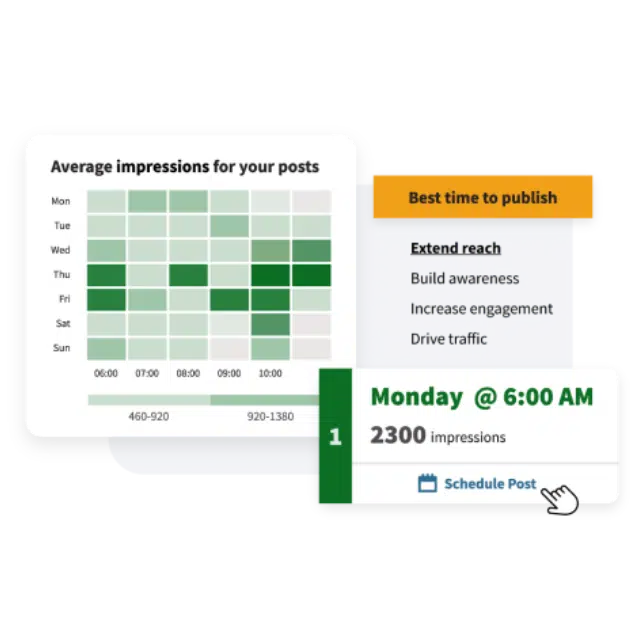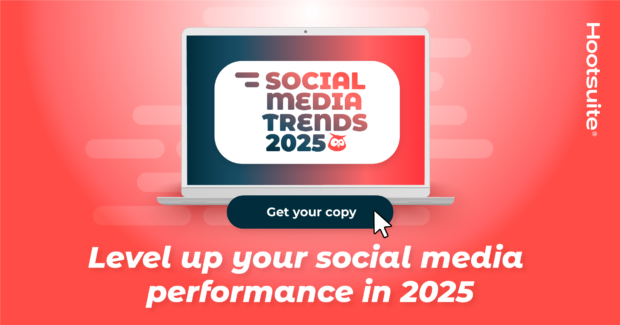If you work in social media marketing, odds are you’ve been told (or haunted by) this one phrase.
Make us go viral.
But hold the eye rolls. After all, who doesn’t want to get their brand in front of as many people as possible?
Well, as is often the case on social media, change is in the cards for 2025. And according to Hootsuite’s 2025 Social Media Trends report, attitudes toward ‘going viral’ have soured.

The question is, is viral marketing still the ticket to social media stardom in the last bit of this quarter-century? And how do you tackle the inevitable request from your boss?
With insights (and hot takes) from marketing experts, we’re breaking it all down below.
What is viral marketing?
Viral marketing is a strategy that aims to create content worth sharing. Once it ‘goes viral,’ the goal is rapid, organic spread from person to person through social networks.
Going viral is highly desirable because it’s a cost-effective way to quickly expand your reach. When organic content resonates with wide audiences and is easy to share, brands get to generate buzz and build awareness of their products or services with new demographics. Super viral content can even get you coverage in traditional media, expanding your reach even further.
A very brief history of ‘going viral’
When word-of-mouth marketing went digital in the late 90s, internet goers everywhere witnessed the true meaning of “the snowball effect.”
From the rapid spread of Hotmail to unhinged video ads not quite fit for TV and other traditional marketing channels, the internet became a sandbox for marketers to find their legs in a new era of consumerism.
Think about how fun the early days of social media platforms like YouTube, Twitter, and Facebook were. With audiences so attracted to the newness of social channels, creating shareable content became the ultimate way to appeal to a growing, hyper-engaged audience. And, the most valuable social currency for digital marketers.
But relying on viral marketing is risky. Going viral relies on a mix of timing, relevance, audience engagement, and good ol’ luck. You can’t exactly plan to go viral — but more on that later.
3 examples of successful viral marketing campaigns you probably know
… because they went viral.
1. Duolingo & Dua Lipa
Duolingo’s social media presence needs no introduction — they’ve simply mastered brand awareness, largely thanks to their delightfully weird TikTok presence.
But perhaps their best example of viral marketing is their use of consistent storylines. More specifically, their mascot Duo’s crush on pop star Dua Lipa.
What started as a joke about their two similar sounding names (Duo vs. Dua) back in 2022 developed into an easily repackaged viral marketing strategy, garnering millions of engagements, again and again.
And it’s still going strong. In fact, we just might see an official collaboration (hard launch) between the two in 2025.
2. The Stanley car fire
IYKYK: The Stanley tumbler is the emotional support water bottle of the last few years.
And with a mix of paid and organic content flooding (pun intended) the #WaterTok hashtag daily, Stanley owes a lot of its success to a recent viral moment.
When TikTok user Danielle shared the now-viral video of her Stanley keeping her drink ice-cold through a literal car fire, it generated tons of online engagement (and media coverage).
The viral marketing strategy in question? Stanley capitalized on the moment by sending Danielle a new Stanley cup — and replacing her burnt-down vehicle.
This might sound like an expensive one-off engagement, but look at how it increased the interest in the brand in the days following the November 16 video — and just in time for an incredibly successful holiday season.

Source: Google Trends
3. Michael Cera(Ve)
While CeraVe’s skincare products get recommended by dermatologists online and irl, their recent campaign with actor Michael Cera — or Michael CeraVe — made the internet explode with equal parts confusion and excitement.
A.k.a., the perfect recipe for a viral marketing moment.
The conversation first sparked with paid posts from influencers that lightly teased the collaboration:
Then, the brand rolled out a Super Bowl commercial to make the successful viral campaign official.
Now, who can hook us up with one of those limited-edition moisturizers?
Is viral marketing still cool?
The goal of any solid social media strategy is to create engaging, emotional, or useful content that people want to share naturally.
But just because unhinged virality works for the Duolingos of the world (fun, personality-driven B2C brands) doesn’t make it a realistic strategy for every brand. For certain industries, viral moments are few and far between. And trying to force them is likely to make audiences cringe.
So, we asked two digital marketing experts for their thoughts. More specifically, is viral marketing still cool?
As Apollo.io’s Social Media and Video Manager Lindsay Ashcraft puts it, “Viral marketing isn’t cool when you’re creating a piece of content with the sole goal of going viral.”
Jumping on social media trends, for example, can be an effective marketing method for exponential growth — but it doesn’t always serve a purpose. “An impactful social strategy should always focus on building community,” adds Lindsay.
Sophie Miller, Founder & Director of Pretty Little Marketer, is aligned. In fact, Sophie believes virality done right can actually be strategic.
“We always talk about virality and vanity, but not virality and opportunity,” Sophie says.
When Sophie had a recent Instagram post go viral, she capitalized on it.
View this post on Instagram
A post shared by Pretty Little Marketer | Social Media Community
(@prettylittlemarketer)
“That carousel got me featured in Glamour Magazine and The Drum, landed me a paid podcast opportunity, and added 13,000 new followers that I can nurture and sell to.” explains Sophie.
She slips in a hot take: “Instagram isn’t dead and [virality is] not all about TikTok and video content.”
The takeaway? Going viral is cool. What’s cooler is your ability to seize the opportunity in a strategic way that aligns with your business goals.
What makes marketing content go viral?
TL;DR: There are several factors that make for a viral marketing moment.
Timing
When it comes to sweeping the internet, it’s all about being at the right place at the right time.
The key? Posting when your audience is most engaged.
For example, Media & Entertainment brands who post to Instagram Reels in the late morning and early afternoon have a higher chance of driving engagement.

Tip: With Hootsuite’s best time to post feature, you can post at optimal times according to your actual audience and boost your chances of virality!

Always post at the right time
Find out when your audience is online and optimize your posting schedule for maximum engagement. It’s so easy.
Cultural relevance
Whether it’s brat summer or channeling demure and mindful, tapping into the internet’s latest and greatest trends and memes can be worthwhile.
Exhibit A: Buzzfeed highlighting how the Emily in Paris cast arrived to the red carpet.
Exhibit B: Statistics Canada breaking down the data details of Taylor Swift’s The Eras Tour.
Boldness or humor (or both)
It’s not for every brand. But if your strategy (and boss) allows for it, think outside the box.
This brilliant viral marketing campaign generated buzz with models roaming Toronto, wearing garments made entirely of Cashmere toilet paper.
Turns out, it was all leading up to the brand’s fashion show in partnership with the Canadian Cancer Society and Quebec Breast Cancer Foundation. Win-win.
Emotional connection
It’s simple: Marketing content that evokes an emotional response — positive or negative — tends to have a higher chance of going viral.
A noteworthy example? WestJet’s annual “Christmas Miracle” campaign.
*Wipes tears*
Strategy
Not to toot our own horn, but our 2025 Social Media Trends report campaign is proof that viral marketing isn’t an accident.
Our plan of action: Partnering with top social media voices to spread the news about the anticipated release.
The result? Social media managers everywhere tapping in!


Luck
Sometimes the algorithm is on your side, and that’s really all there is to it!
So, what should you do when your boss is expecting viral marketing?
Bad news, social media managers — the infamous viral request probably isn’t going away anytime soon.
But fear not! Sophie and Linsday have all the tips to get you through it.
Find the ‘why’
Why does your boss want to go viral?
“You can usually poke holes in the request when you understand the why,” Lindsay says.
Sophie agrees. “I’ve worked with individuals in the past whose bosses and teams think virality is the ultimate answer to a sell out a launch and complete business transformation.” (Which is extremely unlikely to happen through one piece of viral content, no matter how shareable.)
“Big numbers are great, but what do you want to get out of it? And realistically, can ‘virality’ provide that?” adds Sophie.
Align plans with your brand’s voice and target audience
Know. Your. Niche.
Aka, “Address your target audience by name and include pain points that are very specific to them,” advises Linsday.
“That way, even if you’re tapping into a super popular trending concept, you can ensure it’s more likely to make a meaningful impact versus a one-off spike in views.”
Sophie couldn’t agree more: “Your results are driven by how well you know your landscape and your audience.”
“Who are my audience and where are they? What ‘viral’ content do they already engage with? What have my competitors had success sharing? Going in informed is your best strategy,” Sophie adds.
And trust us, Sophie knows her stuff.
“Brands I’ve worked with in the past use my concept of a platform map to see what virality might look like, test concepts, try trends, and see how their audience responds,” Sophie says.
In conclusion: Map it out.
Give it time (and many tries)
Sophie’s ultimate tip? Adopt a ‘free to fail’ attitude.
“You’ve got to be prepared to post a fire piece only for it to get 30 views and a single like from… you on your personal account,” Sophie says.
“Learning what doesn’t work is just as valuable as learning what does. This is key to highlight when you’re setting expectations with your boss and team.”
Understanding what type of content your audience is most likely to engage with is a step in the right direction.
According to Hootsuite’s quarterly benchmark analysis, for example, LinkedIn posts containing photos generally perform best for Technology companies.

“Check in and optimize — Didn’t work? Cool, a new lesson!” Sophie says.
“How can we optimize for next time? What tweak can we make? Can the hook come in sooner? In hindsight, does that trend actually not resonate with our audience group? Get your team together and discuss!”
Don’t force it
You simply can’t force viral engagement.
Lindsay’s advice? Get your boss involved in all of your marketing efforts, and set realistic expectations.
“Get them to have buy-in and excitement around other meaningful metrics that tie directly back to company goals,” Linsday says.
“You can do this in your weekly or monthly reports to tell the story that matters!”
The ultimate takeaway? Just like more traditional marketing techniques, viral marketing doesn’t guarantee success.
Building and engaging a lasting community? Now we’re talking.
P.S. We totally encourage bookmarking this blog post for the next time you get asked, well, you know.
From a single dashboard, you can publish and schedule posts, find relevant conversions, engage your audience, and measure results across all major social media networks. Try Hootsuite for free today.
The post Viral marketing: Is there a recipe for going viral in 2025? appeared first on Social Media Marketing & Management Dashboard.



